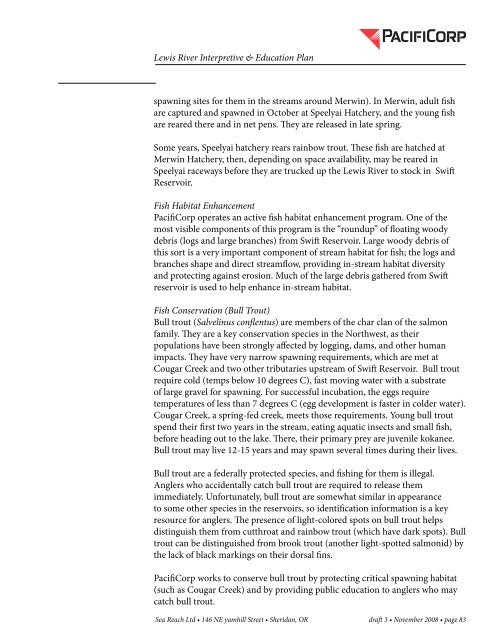The Lewis River Hydroelectric Projects - PacifiCorp
The Lewis River Hydroelectric Projects - PacifiCorp
The Lewis River Hydroelectric Projects - PacifiCorp
Create successful ePaper yourself
Turn your PDF publications into a flip-book with our unique Google optimized e-Paper software.
<strong>Lewis</strong> <strong>River</strong> Interpretive & Education Plan<br />
spawning sites for them in the streams around Merwin). In Merwin, adult fish<br />
are captured and spawned in October at Speelyai Hatchery, and the young fish<br />
are reared there and in net pens. <strong>The</strong>y are released in late spring.<br />
Some years, Speelyai hatchery rears rainbow trout. <strong>The</strong>se fish are hatched at<br />
Merwin Hatchery, then, depending on space availability, may be reared in<br />
Speelyai raceways before they are trucked up the <strong>Lewis</strong> <strong>River</strong> to stock in Swift<br />
Reservoir.<br />
Fish Habitat Enhancement<br />
<strong>PacifiCorp</strong> operates an active fish habitat enhancement program. One of the<br />
most visible components of this program is the “roundup” of floating woody<br />
debris (logs and large branches) from Swift Reservoir. Large woody debris of<br />
this sort is a very important component of stream habitat for fish; the logs and<br />
branches shape and direct streamflow, providing in-stream habitat diversity<br />
and protecting against erosion. Much of the large debris gathered from Swift<br />
reservoir is used to help enhance in-stream habitat.<br />
Fish Conservation (Bull Trout)<br />
Bull trout (Salvelinus conflentus) are members of the char clan of the salmon<br />
family. <strong>The</strong>y are a key conservation species in the Northwest, as their<br />
populations have been strongly affected by logging, dams, and other human<br />
impacts. <strong>The</strong>y have very narrow spawning requirements, which are met at<br />
Cougar Creek and two other tributaries upstream of Swift Reservoir. Bull trout<br />
require cold (temps below 10 degrees C), fast moving water with a substrate<br />
of large gravel for spawning. For successful incubation, the eggs require<br />
temperatures of less than 7 degrees C (egg development is faster in colder water).<br />
Cougar Creek, a spring-fed creek, meets those requirements. Young bull trout<br />
spend their first two years in the stream, eating aquatic insects and small fish,<br />
before heading out to the lake. <strong>The</strong>re, their primary prey are juvenile kokanee.<br />
Bull trout may live 12-15 years and may spawn several times during their lives.<br />
Bull trout are a federally protected species, and fishing for them is illegal.<br />
Anglers who accidentally catch bull trout are required to release them<br />
immediately. Unfortunately, bull trout are somewhat similar in appearance<br />
to some other species in the reservoirs, so identification information is a key<br />
resource for anglers. <strong>The</strong> presence of light-colored spots on bull trout helps<br />
distinguish them from cutthroat and rainbow trout (which have dark spots). Bull<br />
trout can be distinguished from brook trout (another light-spotted salmonid) by<br />
the lack of black markings on their dorsal fins.<br />
<strong>PacifiCorp</strong> works to conserve bull trout by protecting critical spawning habitat<br />
(such as Cougar Creek) and by providing public education to anglers who may<br />
catch bull trout.<br />
Sea Reach Ltd • 146 NE yamhill Street • Sheridan, OR draft 3 • November 2008 • page 83
















